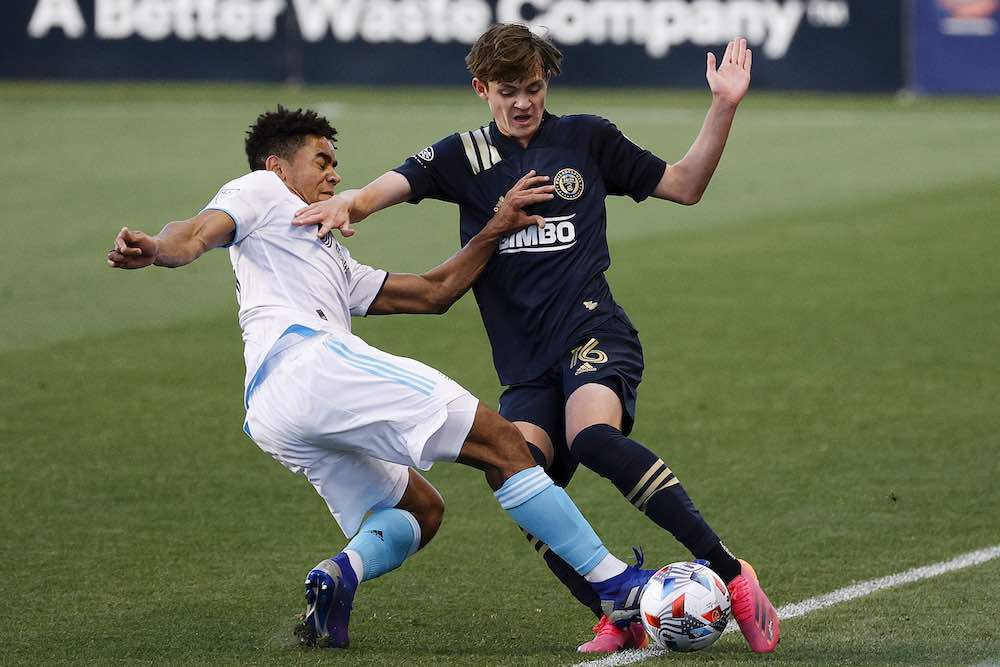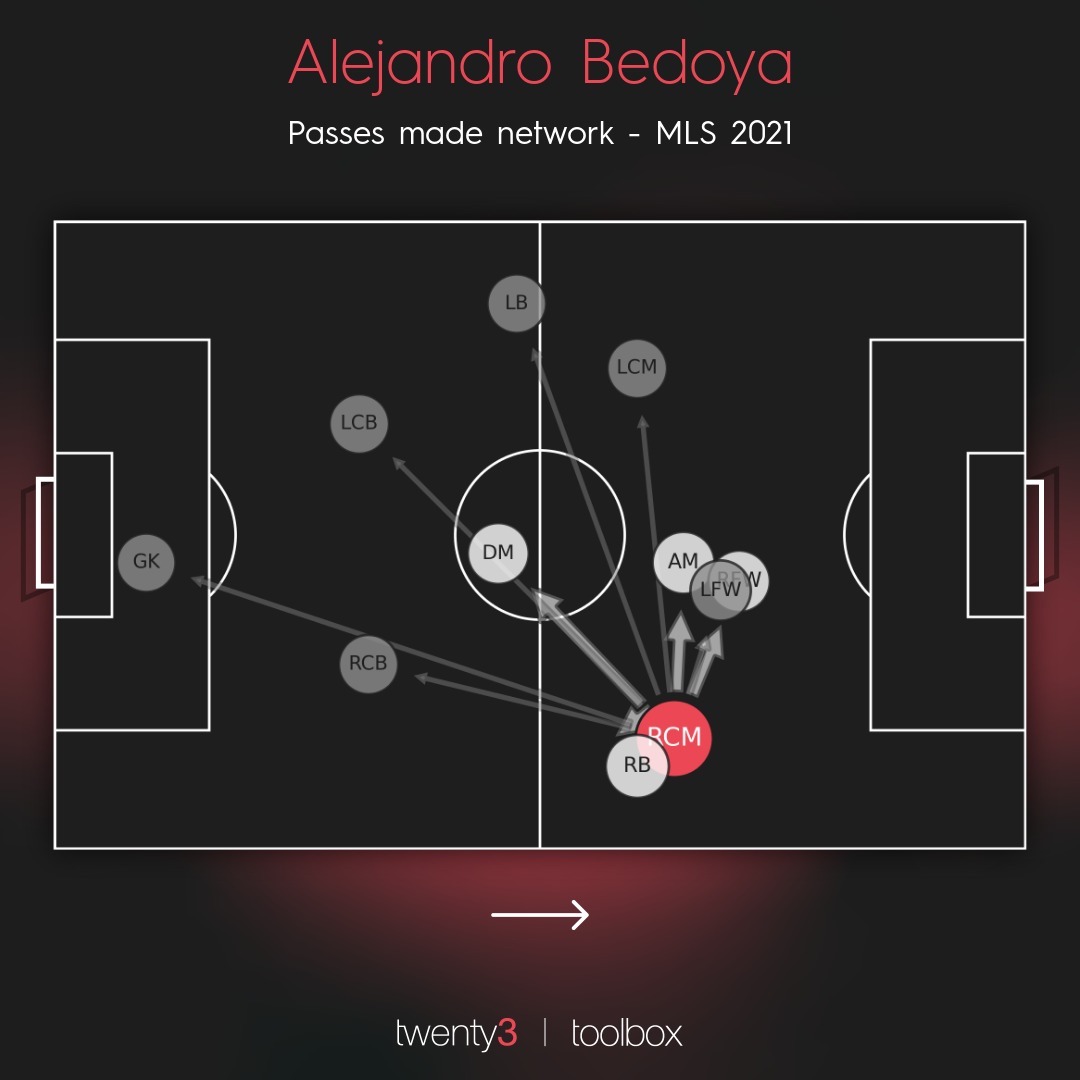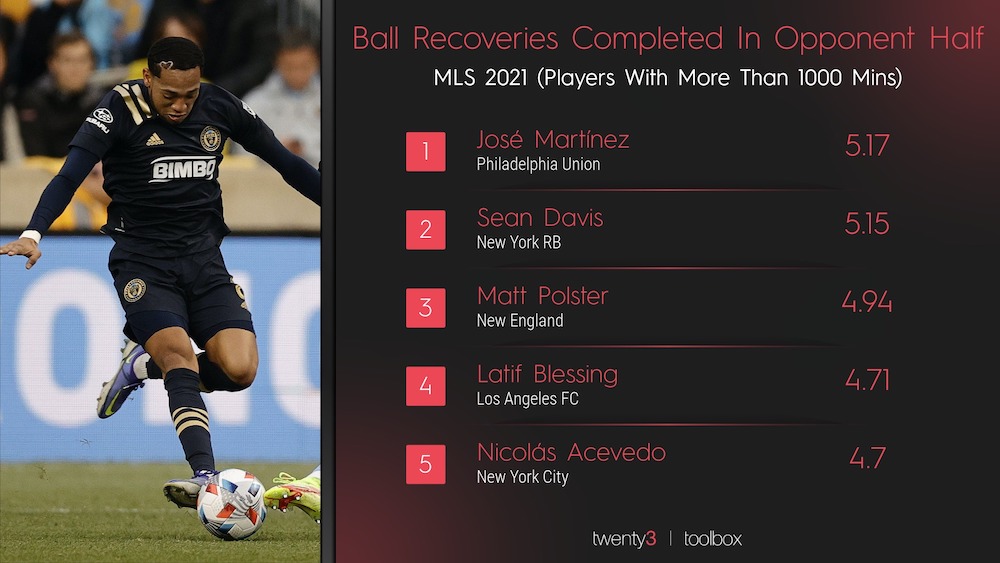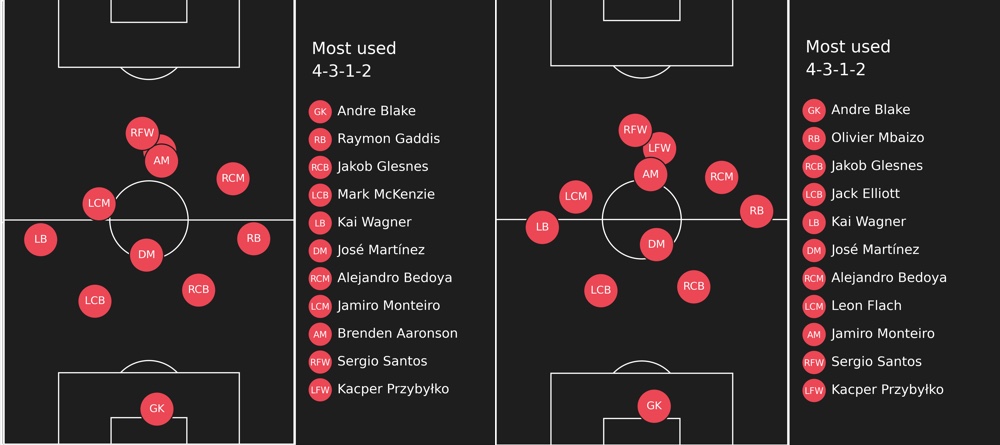By James Nalton, with data visualisation courtesy of the Twenty3 Toolbox.
It was always going to be a struggle for the Philadelphia Union to repeat their Major League Soccer Supporters’ Shield success of 2020, but 2021 was still a positive year for the club in a number of ways.
At the end of 2020, they lost two players from the core of the side. Players who were key to their success that year.
Centreback Mark McKenzie joined Belgian side Genk and attacking midfielder Brenden Aaronson jumped on Red Bull’s conveyor belt, joining their Salzburg franchise.
Union managed an average of 1.58 points per game in 2021 which, though lower than the 2.04 that saw them top the Eastern Conference and the overall table in 2020, is still the club’s third-best points per game tally in their 12 seasons in MLS.
That they did that having lost those two players is a testament to both the club’s recruitment, academy, coaching staff, and those players who stuck around.
The Union have become one of the most interesting teams in MLS when it comes to emerging talent. In 2021 three teenagers were given more than 500 minutes each, while eight homegrown players were used throughout the campaign.
The emergence of Brenden Aaronson’s younger brother, Paxten, was notable, as were appearances in the first team for Jack McGlynn, Quinn Sullivan, Nathan Harriel, Anthony Fontana, and Matt Freese.

Jack McGlynn (R)
There are others coming through, too, such as Matt Real, Anthony Sorenson, and Brandan Craig, while 20-year-old American-born German-raised midfielder Leon Flach was one of their most-used players in 2021 having signed from FC St. Pauli in March.
Union’s success in 2020 saw them qualify for the Concacaf Champions League for the first time. Depleted squads post qualification is common throughout the Americas as European sides pick up the standout players, but despite losing McKenzie and Aaronson, they acquitted themselves well, reaching the semi-finals.
They kicked off their 2021 season in this competition in April, and while the Round of 16 win against Costa Rican side Saprissa didn’t explain it all, there were signs across the two legs that the tactics from the 2020 season would remain.
Philadelphia Union formation at Saprissa in the Champions League. Bit of a midfield diamond going on. Monteiro a roaming No. 10. #DOOP #SCCL21 pic.twitter.com/jeYljIkIMv
— James Nalton (@JDNalton) April 7, 2021
That lineup is an example of the shape Jim Curtin has used more often than not during his time as Philadelphia Union’s head coach.
The formation can be explained in numerical terms as either a 4-4-2 diamond or a 4-3-1-2.
The latter of these two descriptions might be the easiest to use for the purposes of analysing how the system works, especially as the midfield three are fairly flat when defending, but many of the hallmarks of a traditional 4-4-2 diamond remain.
There’s the usual back four, containing two full-backs who bomb forward to provide attacking width and creativity from the flanks.
These fullbacks-turned-wingbacks can solve a problem teams using this formation can sometimes encounter, which is a lack of width either side of the forwards, but Curtin has also used another method to add numbers in attacking areas.
In Curtin’s version of this system, the outside players in the midfield three can also find themselves in wide attacking positions.
These two midfielders almost become inside forwards at times and can give the team a very attacking shape, but it’s often the case that if one fullback or one wide midfielder gets forward, the teammate on the opposite side of the field hangs back slightly.
As a result, along with the vital width provided by the full-backs, one of the most important players in this setup is experienced attacking midfielder, Alejandro Bedoya.
Bedoya has been tactically versatile for his previous clubs and spent some of his time with French side Nantes playing on the right-wing.
For the Union, he has been perfect for that right-sided role in the midfield three (the right of the diamond).
Sometimes the stats websites will even list his position as right midfield, rather than centre, such is his tendency to drift to the flank.
His passes-made network below shows his position in the diamond relative to the defensive midfielder (DM), left midfielder (LCM), attacking midfielder (AM) and the rest of the team.

Alejandro Bedoya (RCM) – passes made network 2021
The system also opens up a chance for the fullbacks/wingbacks to shine. German left-back Kai Wagner took that chance and was one of the best in his position in MLS in 2021, standing out in his third season at the club.
He was second in the league overall for total expected assists, behind New York City’s Icelandic left-back, Gudmundur Thórarinsson

On the other side, Olivier Mbaizo remains a promising young prospect despite a lack of consistency, and the Cameroonian should be raring to go in 2022 after his country has hosted the Africa Cup of Nations this month.
Defensive midfielder José Martínez is key to providing cover when the wide midfielders and full-backs bomb forward and, as shown below, is one of the best in the league at recovering possession in the opposition half.

The graphics below show how similar the team shape has been in the previous two seasons, and show once again the advanced and slightly wide position Bedoya takes up as the right-sided midfielder in the three.
Flach came in for Brenden Aaronson in the most used lineup, with Jamiro Montero pushing up into what is probably his more natural role as a No. 10.
Jack Elliott, a backup centreback in 2020, came in for McKenzie, with Scottish centreback Stuart Findlay arriving to provide backup.
Elsewhere, Hungarian attacker Daniel Gazdag arrived as a player who could play either the No.10 role or as one of the two strikers and began to show his worth towards the end of the 2021 season.

Philadelphia Union average positions 2020 (L) and 2021 (R). Source: Twenty3 Toolbox
Though there are changes in personnel — something which is unavoidable for an MLS club that produces talented homegrown players — there is also a continuation of the playing style and structure. This offers stability at the club even if there is some degree of player turnover.
Philadelphia Union could retain a consistent starting XI going into the 2022 season, though, with Paxten Aaronson and the likes of Sullivan and McGlynn playing increasingly key roles before they themselves will attract attention from abroad.
Alumnus Brenden Aaronson’s performance at Salzburg have been so impressive that he’s already tipped for a move to the top of the Red Bull ladder to RB Leipzig, but clubs around Europe will be also be considering a bid. He’s also been one of the standout American players generally in 2021.
The Union are well set up to produce more players who will go on to have a career in Europe, but they also aim to be successful in the present.
Though 2021 was a slight comedown from the 2020 Suppoerts’ Shield win, it was still a success in many ways.
This is thanks to the way the team is set up by Curtin, the recruitment of handy replacements for the players who left, and their own conveyor belt of young talent.
It will be exciting to see how 2022 unfolds for one of the most interesting teams in Major League Soccer.


COMMENTS